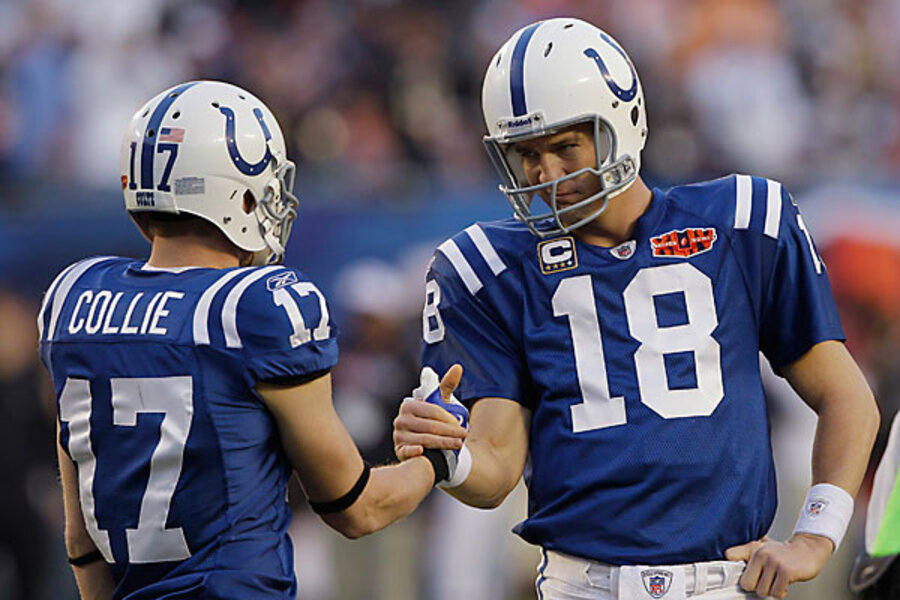Super Bowl: 10 things to watch
Loading...
| Miami
In two weeks, the world has heard a lot about Dwight Freeney’s injured ankle but learned very little. The word “shootout” has been used 748,212 times to describe the prospects for Super Bowl XLIV. And we’ve been made to believe that a Super Bowl title might be met with some mild excitement in the French Quarter of New Orleans.
At last, when another day of media speculation would seem a violation of the Geneva Convention, the game between the New Orleans Saints and Indianapolis Colts is here.
As America sits down to queso dip and Doritos commercials, here is a cheat sheet to 10 key things to look for:
1. Saints rushing. The Saints are unquestionably quarterback Drew Brees’s team. Yet statistics show that they are at their best offensively when they run the ball as much as they throw it.
When the Saints relied too much on the pass – passing the ball at least 10 times more than they ran it – they averaged 28 points per game. In their other games, they averaged 37 points per game. In a Super Bowl where the Saints could well have to score more than 30 points to win, the running game could be as important as the passing game.
2. A game, for once. It is not for nothing that the Super Bowl has become known for its advertisements. For many of its 44 years, the game itself has held far less drama than the question of who would win the Bud Bowl or whether Terry Tate: Office Linebacker would make another appearance.
Between 1980 and 1995, the winning team triumphed by an average of 20 points – nearly three touchdowns. By halftime, most Super Bowl parties were looking for a new reason for being.
But seven of the past 12 Super Bowls have been decided by seven points or fewer. And seven of the 31 Super Bowls before 1998 had been decided by a touchdown or less.
3. Freeney: Bionic man? Earlier this season, Colt defensive end Freeney suffered an injury that was supposed to keep him out for more than a month. He played the next week.
Now, he is carrying an ankle injury that, again, would suggest more than a month of recovery time and perhaps surgery. He may play Sunday. For a Colt defense built on the concept of pressuring the quarterback with a minimum of blitzes, Freeney is a linchpin. When he suffered a season-ending injury in 2007, the Colts lost their first playoff game.
How he responds to injury tonight could be a major factor in how well the Colts play defense.
4. Colts rushing. The Colts are, by some measures, the worst rushing team in the NFL. But then again, the Saints are one of the worst rushing defenses in the NFL.
The Colt rushing attack is hampered by an offensive line built to protect quarterback Peyton Manning, not to block for the run. But it has two decent running backs in Joseph Addai and Donald Brown. The Colts don’t need the run to win – they passed more than they ran in every game this year – but it could make them harder to stop offensively.
5. The X-Factors. The Saints have an embarrassment of offensive riches. But two players in particular befuddle opposing defenses with their versatility. If the Saints are able to get tight end Jeremy Shockey and running back Reggie Bush involved in the offense, it could create a devastating domino effect within the Colt defense, forcing match-up problems across the field.
6. No field goals please. For years, the greatest success of the Colt defense has been its bend-but-don’t-break ability to limit opponents to field goals instead of touchdowns. Tonight, every field goal forced would be a significant victory for either defense.
7. A study in opposites. Both offensively and defensively, the Saints are built on deception, while the Colts are built on simplicity. All game, the Saints will be asking the questions – lining up in a dizzying array of offensive formations and sending an exotic package of blitzes – and the Colts will be seeking to respond.
8. Team speed. On offense, the onus is on Manning to unravel the Saints’ defensive schemes. On defense, the Colts will rely on track-sprinter speed. Though they have become slightly more aggressive this year, the Colts essentially play a conservative brand of defense – preventing big plays and using their team speed to react.
An analysis by Football Outsiders suggests this is the best defense to play against the Saints. But if the Saints can have success running the ball, it might open up bigger plays down the field.
9. Don’t leave early. No teams have scored more points in the last two minutes of the first half than the Colts and Saints. In the postseason, the Colts have scored 21 of their 50 points in those two minutes. With two masters of the two-minute drill as quarterbacks, two minutes is an eternity.
10. Turnovers. The Saints have masked significant defensive flaws by becoming one of the best teams at taking the ball away from the other team. Without turnovers, the Saints defense can be exposed against both the run and the pass. But they have made turnovers an art form.
--
Follow us on Twitter.





